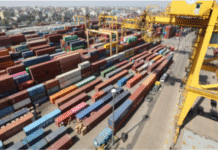

Inflation jumped to a 12-month high in October as elevated levels of commodity costs in the international markets translated into higher consumer prices in Bangladesh, official figures showed yesterday.
The Consumer Prices Index rose 11 basis points to 5.7 per cent from September’s 5.59 per cent and was up for the third consecutive month, according to the Bangladesh Bureau of Statistics (BBS).
The increase in the general inflation was driven by non-food inflation, which surged to a 62-month high in October.
The non-food inflation rocketed to 6.48 per cent last month from 6.19 per cent a month ago. This has been the highest since August 2016 when it stood at 7 per cent, Bangladesh Bank data showed.
Rising inflation in Bangladesh is largely the victim of the record levels of commodity prices in the global markets as demand recovery from the coronavirus pandemic, an unprecedented level of shipping charges, and supply constraints pushed up the prices of essentials, mounting pressures on the import-dependent countries.
For example, the freight rate for a 40-foot container to European ports from Chattogram has reached the $15,000 level, which was hovering around $1,500-$2,000 one year back, according to an analyst.
Freight costs to the major US ports increased five-fold compared to that of last year. In case of imports, the rate has doubled in recent times.
Bangladesh is not the only country that was hit with the higher inflation rate.
For example, the annual rate of inflation in the United States rose to 6.2 per cent in October, the highest in more than three decades.
The jump in inflation to 4.2 per cent in the UK was the sharpest in a decade. Inflation in the eurozone is now 4.1 per cent, a 13-year high, according to the Guardian newspaper.
In France, October’s annual inflation rate was 2.6 per cent, the highest since 2008, pushed up by a 20 per cent surge in energy prices. China’s annual inflation rate rose to 1.5 per cent, the highest for 13 months.
Washington-based Pew Research Center’s analysis of data from 46 nations finds that the third-quarter 2021 inflation rate was higher in most of them, or 39 countries, than in the pre-pandemic third quarter of 2019.
In Bangladesh, food inflation is at a higher level for the elevated commodity prices in the international markets. It was up one basis point at 5.22 per cent in October.
This is because rice price has not gone down despite higher imports in recent months and robust domestic production. Similarly, the prices of key essentials such as cooking oil and sugar are on the rise, while vegetable prices have not cooled despite the arrival of winter crops.
Inflation in rural areas was up four basis points at 5.81 per cent last month, while urban inflation soared by 25 basis points to 5.50 per cent, BBS data showed.
Zahid Hussain, an economist, attributed the jump in the headline inflation to both rising demand and cost.
“The demand is rising with increasing normalisation of economic activity following a persistent decline in virus infection rates. This unfolding of pent-up demand is probably a temporary phenomenon.”
The inflation may increase further in the coming months as the 23 per cent price hike of diesel and kerosene on November 4 has already raised the transport cost of movement, both for individuals and goods.
The government adjusted the energy costs to help state-run Bangladesh Petroleum Corporation recover losses from the surging global energy prices.
A finance ministry official says inflation usually goes up in the first two to three months after the fuel price is hiked.
Hussain says while the international commodity prices are currently easing, the knock-on effects of diesel and gas price adjustments and the subsequent increase in the transport fares have still not passed through the rest of the economy.
“I will, therefore, not be surprised if the rise in inflation continues for a few more months.”
In Bangladesh, there are many essential items such as palm oil, soybean and wheat whose prices are set by the government.
“The commerce ministry should closely monitor the movements in import prices of these items and adjust them downwards because they have been declining recently,” said Hussain.
The economist also urged the government to assess whether the practice of administered prices has produced the desired results.
“Even if we want to manage prices, it is best done through a formula-based pricing that makes the basis of pricing decisions very transparent and limits the use of bureaucratic discretion.”









